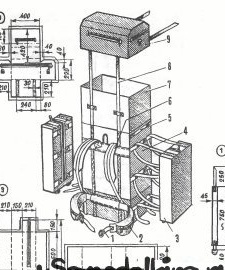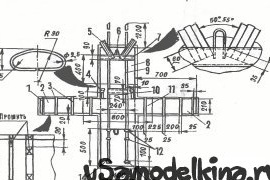
Below is the opportunity to save money without losing quality. Homemade backpack! And not simple, but compound, i.e. consisting of several sections. Each section can be used both in the module with the main parts, and separately. Our backpack will consist of the main part - a bag, two side pockets, a superstructure on top and two hanging bags attached to the belt.
The volume of the main department is 60 liters, which will allow you to place up to 30 kg of cargo; the upper part takes 30 liters and holds another 10 kg, a valve of 15 liters - 5 kg, side compartments of 10 liters - another 10 kg. It turns out that the capacity of our backpack puts 55 kg, which will be very useful in a long trip. This weight is considered optimal for a hiking backpack. It will be maximally filled only at the beginning of the campaign. In your wanderings you will have a snack, and the weight will decrease. Important attention is given to shoulder straps, which will put a strain on the shoulders. They must be wide so as not to stick into the skin, and sufficiently rigid

Homemade Composite Backpack:
1 - belt, 2 - hinged pocket, 3 - side compartment, 4 - main part, 5 - handle, 6 - shoulder strap, 7 - tube, 8 - coupler, 9 - valve.
Bottom straps are attached to rings sewn to the bottom of the backpack. The load belt is used for even weight distribution. The part adjacent to the back is reinforced with foam, giving the backpack a stiff shape. This design allows you to place in the backpack overall things that will not dig into the back.
Rings are attached to the front of the backpack, to which you can attach a mug and other small necessary things. You can place the camera and documents in stitched pockets. There are also double braid handles on top of the backpack for easy transportation on halts.
To adjust the volume of the backpack, there is side lacing. However, with this option, the backpack becomes not monolithic, and you can tip over with it, climbing the mountain. To exclude this possibility, a tube and valve are made.

Main part:
1 - handle, 2 - side compartments, 3 - fastening pockets, 4 - fastening the shoulder strap, 5 - belt, 6 - eyelet, 7 - reinforcing strip, 8 - back frame, 9 - tightening belt, 10 - waist belt, 11 - bottom, 12 - rings, 13 - fasteners, 14 - frontal part.
The valve is equipped with a zipper, so you can put things in it that will be used more than others in the campaign. It is possible to adjust the valve position by means of belts. The valve is removable, it can be used separately from the backpack as a bag. Side segments can be detached. You can use them as small backpacks for small trips. They are attached to the bag with straps and ribbons sewn along the sides of the main bag.
Modern backpacks are made from high-strength synthetic materials. They are resistant to different climatic conditions. The best option would be to use a technical tarp for the manufacture of the backpack. Thinner fabrics will tear, quickly lose their shape in the campaign. However, you can make additional backpack pockets that are not subject to heavy loads. There is also a combination option.
The cord for the shoulder straps is made of nylon. As clamps, metal rings are used. Zippers should be chosen large, plastic.
Build a composite backpack.
Getting to the assembly, it is recommended to perform the following actions: sew fastenings for screeds on the sides of the main department, rings to the bottom. Connect all parts of the backpack, fasten the ties. Sew a cargo belt, shoulder straps, making them from several layers, and, lastly, the sides of the main bag to the bottom. Having fixed all the seams, sew the tube and fasten the rest of the composite backpack.
